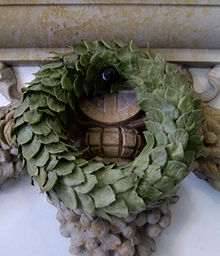Wreath: Difference between revisions
Kevin Kahle (talk | contribs) No edit summary |
Kevin Kahle (talk | contribs) No edit summary |
||
| Line 1: | Line 1: | ||
[[Image:Matthew_Wreath_Enhanced_Brochure_Picture.JPG|thumb| |
[[Image:Matthew_Wreath_Enhanced_Brochure_Picture.JPG|thumb|Christmas wreath by Holiday Enterprises with six bows.]] |
||
[[Image:Rönnbärskrans.jpg|thumb|'''Wreath''' of [[Rowan]] berries]] |
[[Image:Rönnbärskrans.jpg|thumb|'''Wreath''' of [[Rowan]] berries]] |
||
A '''wreath''' is a [[circle|ring]] made of [[flower]]s, [[leaf|leaves]], and sometimes [[fruit]]s, used as an ornament, hanging on a wall or door, or resting on a table. |
A '''wreath''' is a [[circle|ring]] made of [[flower]]s, [[leaf|leaves]], and sometimes [[fruit]]s, used as an ornament, hanging on a wall or door, or resting on a table. |
||
Revision as of 03:53, 13 February 2007


A wreath is a ring made of flowers, leaves, and sometimes fruits, used as an ornament, hanging on a wall or door, or resting on a table.
Symbolism
Wreaths are commonly made by evergreens as a symbol for the strength of life, with these plants overcoming even the harshest winters. Such wreaths often use Bay Laurel (Laurus nobilis) and can be categorized as laurel wreaths. Other components of a wreath can be pine, holly or yew, symbolizing immortality, and cedar, symbolizing strength and healing. The Greek god Apollo is often associated with wreaths, and was a god of life and health. This inspired the Greek to use the symbol as crowns of victory at the Pythian Games, a forerunner to today's Olympic Games. The circularity of wreaths can be used to symbolize eternity or immortality.
Use by culture
These wreaths were festive crowns worn by many Romans. Wreaths were usually for women, and men usually wore crowns. They were a symbol of pride, and they were usually handmade. Most were made of flowers and branches, twigs, thread, and laurels. Wreaths were often used on special occasions such as weddings. They are also used on Remembrance Day (Canada), as a respect to those who fought and died in the Great war.

Greece
A wreath of laurel was used to crown winners of olympic competitions, inherited from one of the symbols of the Greek god Apollo, who is often depicted wearing or holding a wreath of laurel leaves.
Rome
Laurel wreaths were worn on the heads of military and government officials in parades. Roman consuls and senators wore wreaths of olive leaves in public. Funeral wreaths were a Roman custom. They often appear carved on sarcophagi.
Christianity
A wreath made of mostly evergreen tree twigs, sometimes with pine cones and/or a bow made of red ribbon is a common Christmas decoration. Christian households and churches often use an advent wreath made with four (or five) candles in preparation for Christmas.
